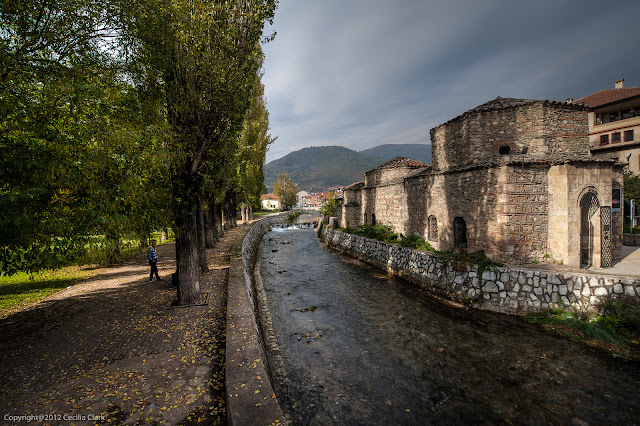We finally made it to Zrze Monastery located northwest of Prilep. From a distance, the monastery seems to hang from a mid-mountain cliff. Caves formerly used as monk cells are located in the cliff face below the monastery. The last few meters of road are quite rutted and rough so we walked the last few hundred meters.
Zrze monastery houses the icon called Virgin of Pelagonia. The original icon is now in the Icon Museum in Skopje, but there is a reproduction of this famous icon in Zrze's Church of Peter and Paul. The icon was painted in 1422. In Macedonian Orthodox tradition, the icon of Jesus is placed on the viewer's right and the Virgin is on the viewer's left. In this church, the placement is reversed. The story goes that the monks placed Mary on the left side of Jesus but each morning, the icons were reversed. Mary spoke to the monks and said that she must be on Jesus' right side because she would never turn her back to her son.
The composition is almost abstract in the body position of Baby Jesus; and the image has so much life in it. The virgin's eyes show such sorrow while the eyes of baby Jesus contain all the wisdom of the world.
The building below is the monastery which contains both the Church of Peter and Paul and the Shepherd's Church (closed for renovations). No photographs are allowed, but the English-speaking monk is quite friendly and knowledgeable about the 14th-century frescos. Even the walls of the porch area are covered with frescos.
A view of the Pelagonia Plain from Zrze Monastery
Horses grazing on the Pelagonia Plain below Zrze Monastery
The next day, with the rental car still in our possession, we drove west to Tetovo to do some sightseeing. Tetovo is a town occupied mostly by persons of Albanian descent, and it has several interesting Ottoman-era structures.
Our first stop was the Painted Mosque. Parts of the exterior of the Painted Mosque (Šarena Džamija) are under renovation, but the inside is finished. We found the mosque locked, but we were handed the key to unlock the door and told to lock up when our visit was finished.
A mosque was first built on this site in 1459. In the 19th-century (1833), the mosque was reconstructed and expanded by Abdurahman Pasha. Abdurahman Pasha's creation, both inside and outside, is in Ottoman-Turkish baroque style. Over 30,000 eggs were used to make the paint used out/inside this unusual mosque.
With all the decorative designs and colors, this mosque looks like a jewel box inside and outside. To the right of the minbar, is a rare (for Macedonia) painting of Mecca.
The next photo is of the Turkish Amam (Ottoman-era bath house) that is located just across the small Pena river from the Painted Mosque. It was also built in the 15th century. Presently, it is an art gallery, but on the day we visited, it was closed. A teenager saw us taking photos and wanted to know why--why we found these buildings interesting?
We also visited the small village of Lešok (northeast of Tetovo) to see the 14th-century church called Sveti Bogorodica. The church was locked, but at the new church we were given a very large key to open the 14th-century church. Once again, we were allowed to visit without a chaperone. When we were finished, we locked the door and returned the huge key.
14th- century Church of Sveti Bogorodica (Holy Mother of God)
The interior is completely covered, walls and ceilings, with frescos from the time of construction as well as from both the 17th and 19th centuries. The 19th-century renovations were sponsored by Abdurahman Pasha--the same Pasha that renovated the mosque and many other structures in Tetovo. Why? Because he was hoping the Orthodox Christians would support him in a revolt against the Ottomans. This didn't work out quite the way he planned. The Ottoman Sultan "volunteered" Abdurahman Pasha to fight the in war in the Crimea from where he did not return.















Comments
Post a Comment